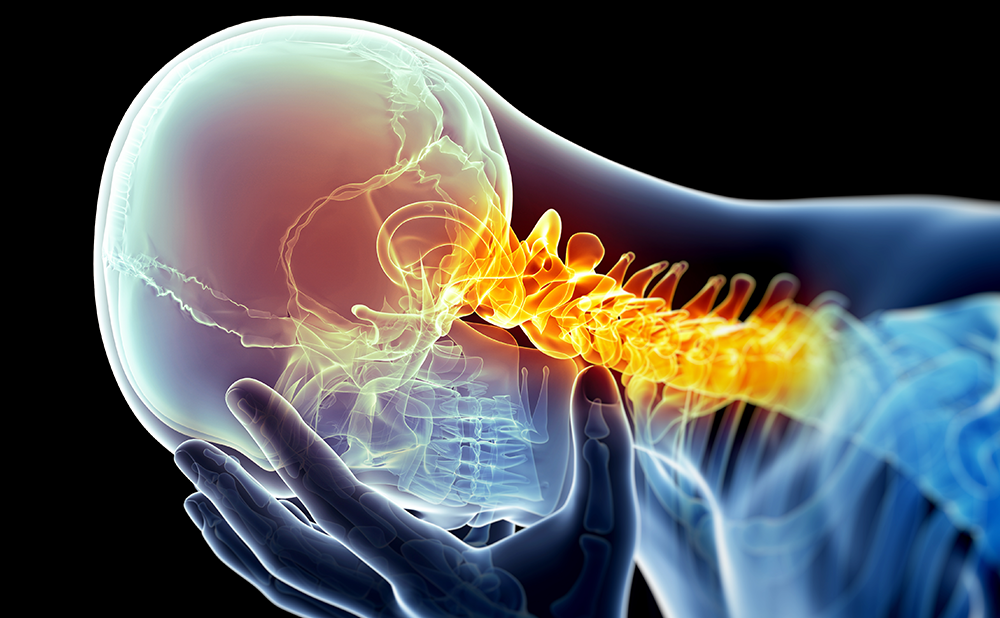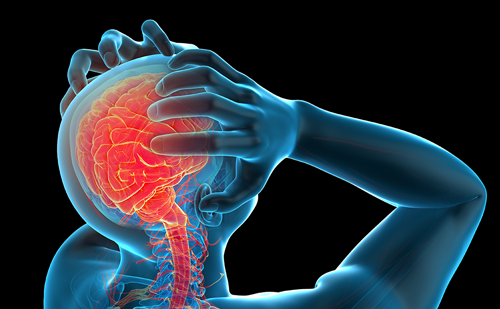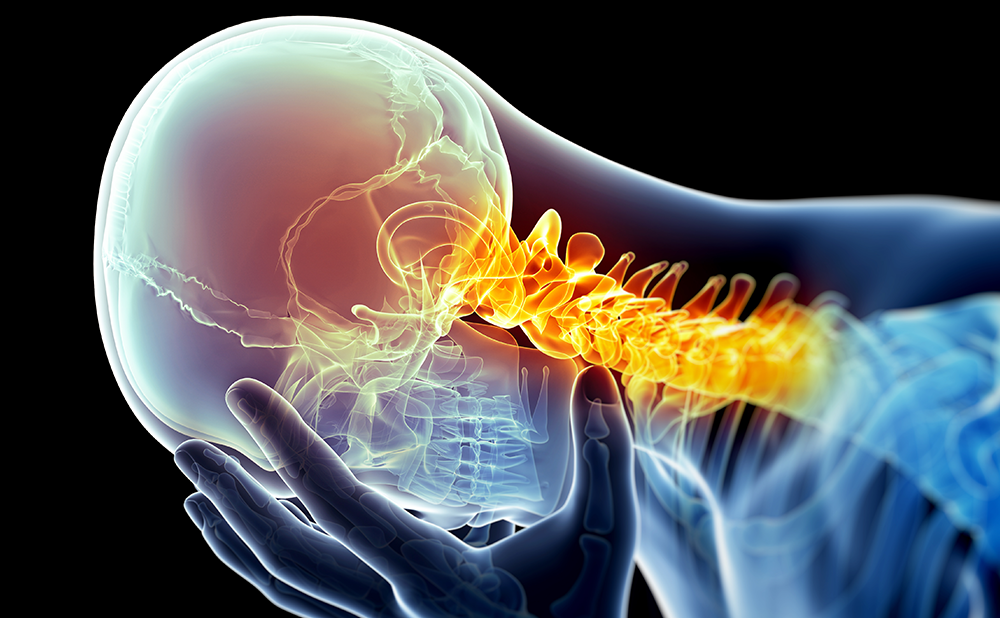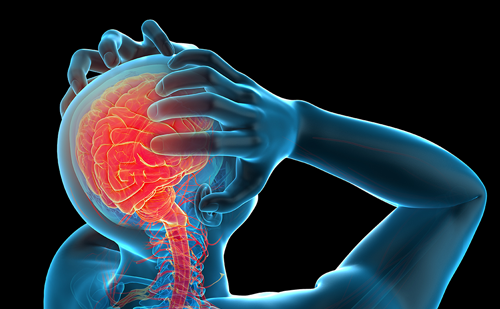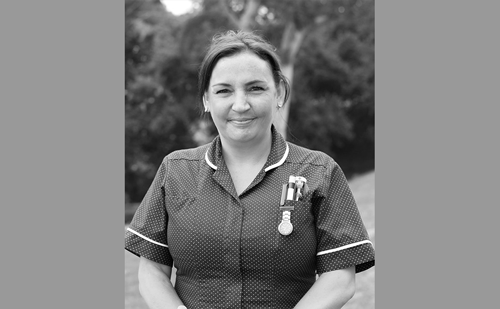History
History
The complexities of chronic post-traumatic headache (CPTH) date back to its initial recognition. By the mid-1800s the persistence of headache after head injury was acknowledged as a manifestation of brain injury or ‘molecular derangement.’ However, with the advent of financial compensation for these injuries, the psychologic aspects were thought to be predominant, hence such terms as ‘compensation neurosis.’ The latter concept persisted into the early decades of the 20th century with more sophisticated terms as ‘somatization’ and ‘conversion disorder’. However, by the late 1800s ‘post-concussion syndrome’ was considered to be a legitimate ailment comprising the triad of headache, dizziness, and alcohol intolerance. In recent decades, post-traumatic headache has been recognized as having an organic or pathophysiologic basis as well as associated psychologic factors.
Terminology and Criteria
The term CPTH implies an underlying cerebral trauma that is part of the post-concussion syndrome. The International Classification of Headache Disorders, 2nd edition (IHCD) divides criteria for CPTH into pain attributed to moderate or severe head injury and pain attributed to mild head injury.1 The term ‘concussion’ in Table 1 is not defined, but would include symptoms such as dazed, confused, memory impairment, and dizziness, in addition to headache or brief loss of consciousness, or both. However, mild head injury without concussion or any other of the IHCD criteria can trigger headache. Examples are migraine with aura evoked by heading a ball during soccer or hemiplegic migraine provoked by trivial head trauma. In addition head trauma need not be direct, such as during blast or whiplash injuries. Trauma may be psychologic, as in chronic post-traumatic stress disorder (PTSD). The time limits indicated in the IHCD criteria have been disputed. Many agree that CPTH may develop more than seven days after trauma, but there is evidence that headache beginning more than three months after concussion is a primary headache (migraine or tension-type) rather than due to brain trauma.2 Until there are biologic markers for the condition, seven days is a logical limit. Similarly, the classification of ‘chronic’ if the headache lasts for more than three months has been disputed as being too short. Criteria of other illnesses define chronic as having a duration of more than six months. The numbers in the classification criteria are arbitrary but necessary operational criteria for research purposes.
Epidemiology
The prevalence of CPTH is uncertain because 80–90% of head injuries are mild and unreported. Studies of prevalence in people who had reported to an emergency department or doctor’s office found CPTH prevalence to range from 15 to 42%.3,4 Women are somewhat more prone to develop CPTH than men.
Paradoxically, CPTH is more common after mild head trauma than following moderate or severe injury.5,6 The reason for this is speculative. Perhaps patients are more focused on the signs of cerebral contusion, laceration, or hemorrhage than on the symptom of headache. Perhaps psychologic and socioeconomic factors are more likely to smolder and bloom when the function of patients is impaired by headache and there are no physical signs to prove their illness to others.
Clinical Features
As indicted by the IHCD criteria, there are no distinctive features of CPTH. Any symptoms of the primary headaches may be manifest. The most common phenotypical presentation is chronic tension-type headache, which occurs in about 80% of cases.7 Post-traumatic migraine is much less common and may co-exist with tension-type headache. The onset of cluster headache has been reported after head trauma and there are rare reports of hemicrania continua, chronic paroxysmal hemicrania, and short-lasting unilateral neuralgiform headache attacks with conjunctional injection and tearing (SUNCT) syndrome associated with head injury. The occurrence of CPTH is greater among people with a past history of headaches or a prior head injury, although these conclusions may be skewed by recall bias.8,9
CPTH is often associated with other post-traumatic syndromes. Most common are the post-concussion and post-traumatic syndromes (the two phrases are often used interchangeably). These syndromes are manifested by somatic (especially neurologic), cognitive, and psychologic features. Headache is the most common symptom; dizziness is next in prevalence. Blurring of vision, photophobia, phonophobia, tinnitus, impaired libido, disordered sleep, and easy fatigue are often noted. Psychologic features include depression, anxiety, change in personality, irritability with angry outbursts, or apathy. Impairments of memory and executive functions were thought to be more subjective than objective and related to poor attention span and difficulty in concentrating, but the recent correlation of subtle neuropsychologic abnormities with changes in magnetic resonance imaging (MRI) diffusion tensor imaging (DTI) suggest a structural cause as well. 10,11 Not any one or combination of symptoms is pathognomonic of the head trauma syndromes. All of these symptoms have been noted in people with chronic pain. 12
Differential Diagnosis
In evaluating patients with headache after trauma one must consider structural lesions such as dural hematoma, arterial dissection, cerebrospinal fluid leaks, and venous thrombosis. Any of the cranial and cervical structures may be injured and cause lasting effects. Medication overuse headache, especially analgesics, may cause acute episodic post-traumatic headache to evolve into the chronic form. PTSD has received growing attention because of its high prevalence in military personnel returning from combat zones. Various manifestations of severe anxiety associated with psychologic trauma are the hallmarks of PTSD. Headache—both migraine and tension-type headache—have been reported in 40% of veterans with PTSD.13
Pathogenesis
Anatomic, physiologic, psychologic, socioeconomic, and cultural factors are interrelated and contribute to the development of CPTH. Whether head injury is direct or indirect (as in blast injuries or whiplash effect), nerve fibers may be torn or stretched, resulting in diffuse axonal injury and microglial clusters.14 The injury may also evoke changes in cerebral metabolism or in intracranial hemodynamics or both.15,16 Excitatory amino acids and inhibitory neurotransmitters may be released; changes in endogenous opioids and nitrous oxide activity may occur. If these changes lead to CPTH, the mechanism is unknown, but the pathophysiology is probably the same as that of other chronic pain syndromes, wherein peripheral sensitization leads to central sensitization, abnormal pain processing, and the development of a self-perpetuating vicious cycle.
CPTH has been studied using many modalities. Standard tests and imaging studies are usually normal. Electroencephalography sometimes reveals asynchormous abnormal slow activity.17 Single-photon emission computed tomography (SPECT) has shown decreased cerebral blood flow and abnormally asymmetrical regional blood flow.18 Brain auditory evoked responses revealed alteration and prolonged latency of some components.19 PET showed a decrease in the metabolic rate of glucose, and other studies revealed release of inhibitory neurotransmitters and excitatory amino acids.15,16,20 MRI sometimes showed cerebral parenchymal lesions.21 Volumetric changes on MRI correlated with the degree of trauma.22 None of these studies is a specific biomarker of CPTH or of chronic cerebral trauma.
A recent advance in MRI DTI measures the neurostructure of white-matter integrity.10,11,23,24 An increase in fractional anisotropy appears to reflect cytotoxic edema or axonal swelling, while a decrease in fractional anisotropy is thought to indicate axonal degradation or gliosis. Studies soon after head injury revealed increased fractional anisotropy with decreased radial diffusivity; the changes then normalized after three to five months,11 while another study found decreased fractional anisotropy at six months after injury.10 These and other studies showed a positive correlation between degree and extent of DTI changes and subtle cognitive abnormalities in neuropsychologic tests. Headache was not specifically studied in these cases of post-traumatic head injury. Hopefully, future studies will confirm DTI abnormalities as biologic markers for mild head injury and as a prognostic tool for headache and other symptoms of CPTH.
In addition to the pathophysiologic changes that may or may not be present in patients with CPTH, psychologic, socioeconomic, and cultural factors must be considered. People with CPTH have higher degrees of psychopathology than those with other chronic pain syndromes.25 Depression and anxiety may be a response to chronic headache and in turn augment pain intensity. Chronic pain may lead to changes in behavior. Withdrawal from physical and social activities may lead to a loss of work, economic stress, and the break-up of relationships. In turn, these stresses tend to perpetuate headache.
Attention to pain plays a large role in its duration and intensity. This has therapeutic implications. On the one hand the physician or care-giver may make light of or ignore the patient’s headaches, or alternatively may reinforce the patient’s symptoms by issuing dire diagnostic labels, ordering many tests, and predicting poor prognosis unless extensive treatments are instituted. Unrelated to the severity of whiplash injury, victims of motor vehicle accidents who consulted physicians, chiropractors, physical therapists, and attorneys took longer to recover than those who did not.26
Expectation of pain may be a self-fulfilling prophesy. After a mild head injury, those patients who believed their symptoms would have serious consequences were at greatest risk for prolonged post-concussion syndrome.27 This result was unrelated to the severity of the injury, anxiety or depression. Expectations of pain and disability are greatly influenced by culture. Americans who had not experienced head trauma were asked to imagine symptoms that would be expected six months after a motor vehicle accident.28 Their answers were similar to a group who had a head injury. Both groups reported symptoms of post-concussion syndrome; headache was at the top of the list, although the methodology of this study has been questioned.29 Canadians and Lithuanians who had not been injured were asked a similar question.30 Forty-five percent of Canadians expected headache for months or years after a motor vehicle accident with loss of consciousness, but only 23% of Lithuanians matched this expectation. The expectation of chronic neck pain in Canadians and Lithuanians was 44 and 1%, respectively. The expectations of chronic post-concussion symptoms among Germans and Greeks were also much lower than in Canadians.31,32
Social and economic factors may play a role in CPTH. In evaluating patients with disability following head injury, 79% of those with mild head injury had headaches after three months.33 In those with longer-term disability there had been lower levels of education, employment, and income; higher levels of life stresses were also noted in this group.
Although malingering is not common, the relationship of secondary gain to CPTH is problematic. Most people with head and neck injury return to work before litigation is settled, and CPTH as well as other symptoms often persist after a favorable verdict.34 On the other hand, in litigation “if you have to prove you are ill, you cannot get well.”35 After head injury, those with financial motives had more symptoms and disabilities than those in a control group.36 In people hospitalized for postconcussion syndrome, the duration of work loss was much greater in those who claimed compensation than those who did not.37 In Lithuania and Greece, where litigation is minimal, there is a low prevalence of post-traumatic symptoms.30,38 The best prognosis in people with whiplash injuries was noted in those societies that have the fewest disability payments, no compensation for pain and suffering, and little litigation.26 In summary, the many organic, psychologic and external factors that may play a part in the development of PCTH are inextricably interwoven.
Treatment
The treatment of CPTH is similar to that of the primary headaches. Chronic tension-type headache is the most common manifestation of CPTH. A combination of pharmacologic and non-pharmacologic treatment modalities is superior to either one alone.39 Of the pharmacologic agents, tricyclic agents such as nortripyline are the initial drugs of choice. All of the prophylactic agents used for chronic migraine may be tried including the antiepileptic agents (topiramate and divalproex), beta adrenergic blockers, and newer antidepressants. Exacerbations of headaches may be treated with triptans if the symptoms are those of migraine or with analgesics including opioids if necessary. As CPTHs occur daily or almost daily, the overuse of analgesics or other agents for acute headache is a major concern. Acute agents must be limited to two days per week to prevent the rebound perpetuation of daily headache (exceptions to this rule may be occasionally necessary). Occipital nerve blocks may be helpful. Hospitalization may be advisable to withdraw the patient from the overuse of analgesics including opioids, or for therapy with intravenous dihydroergotamine or other agents. Associated symptoms of depression, anxiety, and insomnia may aggravate and perpetuate CPTH. Treatment of these conditions may markedly improve the patient’s quality of life.
Non-pharmacologic measures are at least as important as drugs for the treatment of CPTH. As headache and other pain syndromes involve interactions of biology, behavior, emotions, cognition, and environmental factors, the concept and techniques of behavioral medicine are invaluable.40 The evidence-based data and meta-analyses regarding behavioral medicine for headache have recently been summarized.40 The non-pharmacologic treatments include cognitive behavioral therapy, bio-behavioral training (biofeedback, relation training, stress management), education including lifestyle modification, and physical therapies. All are designed to enhance personal control. Cognitive behavioral therapy teaches methods to modify thoughts, feelings, and behavior. Patients learn to be aware of headache triggers, including the relationship of stress to headache. Counterproductive beliefs are identified. The patient should be educated regarding proper use of, compliance with, and adherence to therapeutic modalities. Education also includes recognition of the overuse of medication, the mechanism and potential triggers of headache, and the benign but chronic nature of headache. Psychologic comorbidities such as depression, anxiety, and obsessive–compulsive disorder have been noted in people with migraine and must be considered and treated in patients with CPTH. It is important that the patient take an active role in headache control and follow through with the therapeutic plans.
Many people with CPTH (and other primary headaches) have been given short shrift by their doctors and have lacked psychologic support from significant others. We must educate patients, family members, and care-givers about the legitimacy of CPTH in the absence of objective signs or positive laboratory tests. The value of an empathetic physician or health provider cannot be overemphasized. ■


